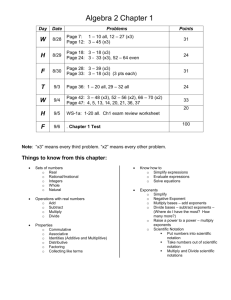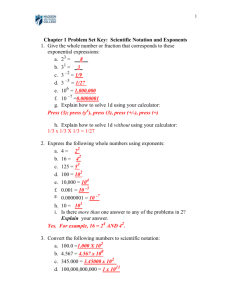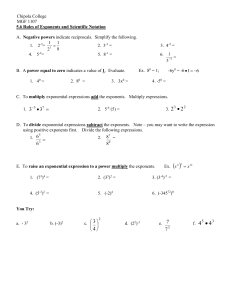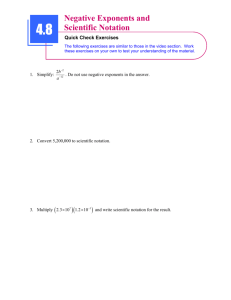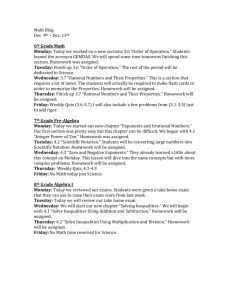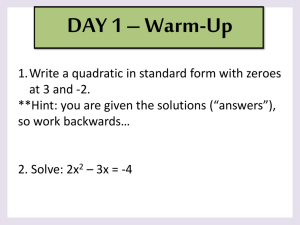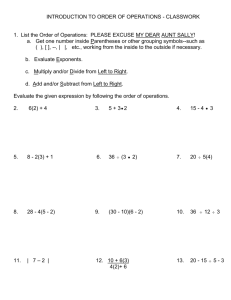Learning Plans for E. Pauley Content/Grade: 7th Grade Accelerated
advertisement
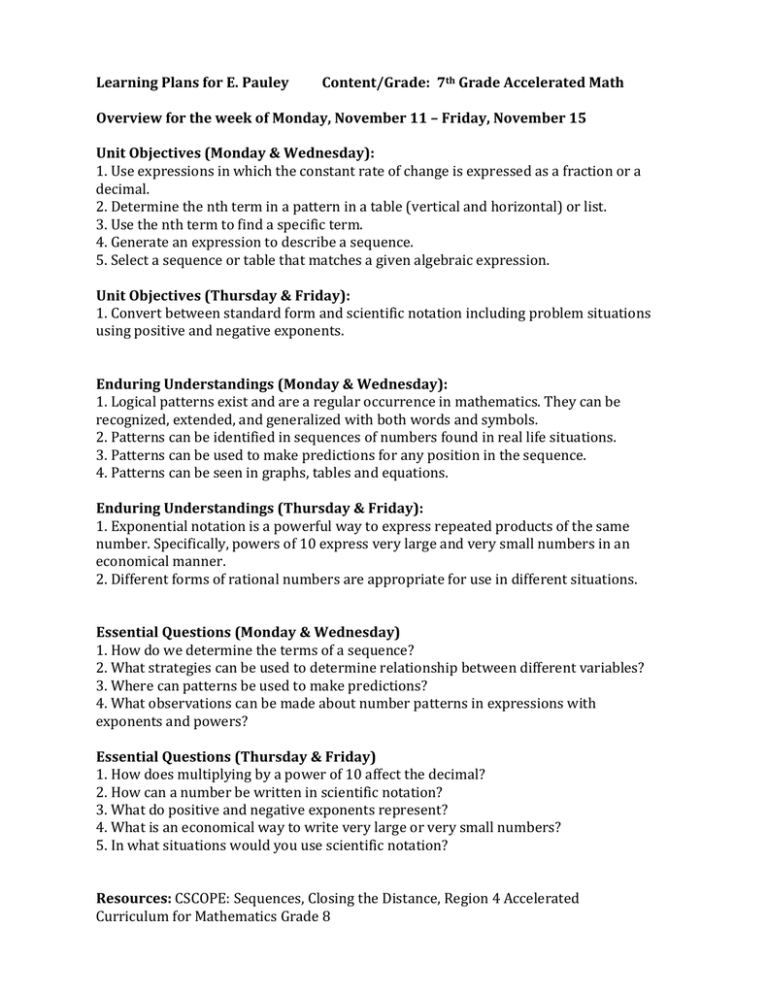
Learning Plans for E. Pauley Content/Grade: 7th Grade Accelerated Math Overview for the week of Monday, November 11 – Friday, November 15 Unit Objectives (Monday & Wednesday): 1. Use expressions in which the constant rate of change is expressed as a fraction or a decimal. 2. Determine the nth term in a pattern in a table (vertical and horizontal) or list. 3. Use the nth term to find a specific term. 4. Generate an expression to describe a sequence. 5. Select a sequence or table that matches a given algebraic expression. Unit Objectives (Thursday & Friday): 1. Convert between standard form and scientific notation including problem situations using positive and negative exponents. Enduring Understandings (Monday & Wednesday): 1. Logical patterns exist and are a regular occurrence in mathematics. They can be recognized, extended, and generalized with both words and symbols. 2. Patterns can be identified in sequences of numbers found in real life situations. 3. Patterns can be used to make predictions for any position in the sequence. 4. Patterns can be seen in graphs, tables and equations. Enduring Understandings (Thursday & Friday): 1. Exponential notation is a powerful way to express repeated products of the same number. Specifically, powers of 10 express very large and very small numbers in an economical manner. 2. Different forms of rational numbers are appropriate for use in different situations. Essential Questions (Monday & Wednesday) 1. How do we determine the terms of a sequence? 2. What strategies can be used to determine relationship between different variables? 3. Where can patterns be used to make predictions? 4. What observations can be made about number patterns in expressions with exponents and powers? Essential Questions (Thursday & Friday) 1. How does multiplying by a power of 10 affect the decimal? 2. How can a number be written in scientific notation? 3. What do positive and negative exponents represent? 4. What is an economical way to write very large or very small numbers? 5. In what situations would you use scientific notation? Resources: CSCOPE: Sequences, Closing the Distance, Region 4 Accelerated Curriculum for Mathematics Grade 8 Monday, November 11, 2013 & Tuesday, November 12, 2013 (The Math Benchmark will be given on Tuesday, November 12.) Learner Objectives: 1. Find and evaluate an algebraic expression to determine any term in an arithmetic sequence (with a constant rate of change). (8.5B) I can generate expressions & find specific terms in a sequence. I will complete a scavenger hunt. Formative Assessments: Muddiest Point, Self Evaluation Teaching Strategies: To complete our Sequences Unit, we will play Deal or No Deal on Monday. Topics will include arithmetic sequences, common differences, nth terms, writing expressions, verbal descriptions, and geometric sequences. The students will take the Sequences Test on Wednesday. A. Students will create tables and write expressions for sequence word problems. B. Students will solve challenging and fun sequences that are not arithmetic. Wednesday, November 13, 2013 – Friday, November 15, 2013 Learner Objectives: 1. Express numbers in scientific notation, including negative exponents, in appropriate problem situations. (8.1D) I can use exponents to solve real-world problem situations. I will determine the relationship between the number of ballots cut & the area of the paper. Classwork/Homework: Ballot activity & IXL (F2 & F3) 15 minutes/standard I can use exponents to solve real-world problem situations. I will justify which salary plan is the best based on my Frayer model. Classwork/Homework: Frayer Model & IXL (F6 & F7) 15 minutes/standard I can translate numbers in standard form to scientific notation. I will be able to match numbers in standard form to scientific notation. Classwork/Homework: IXL (G1 & G2) 15 minutes/standard Formative Assessments: Paint the Picture, Shift Statement Teaching Strategies: Before students begin solving expressions with scientific notation, they need a conceptual understanding of negative exponents. We will start by completing an activity that will allow students to discover the rule for negative exponents by exploring exponential patterns. After investigating practical uses for negative exponents and simplifying negative exponent expressions in both directions, students will solve a series of measurement problems that have very small decimal answers. All solutions will be expressed with negative exponents. Differentiation: A. Students will simplify expressions with positive exponents. B. Students will create a graph to show exponential decay.
